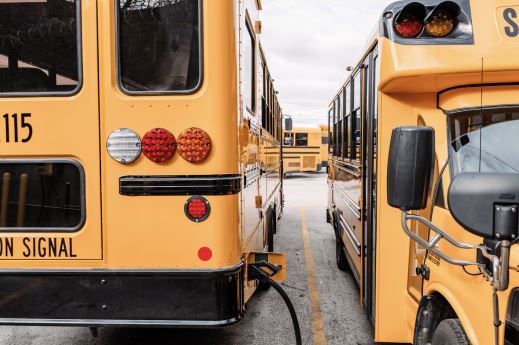U.S. DOE Awards Highland Electric Fleets’ Project Approximately $10.9M in Cost-share Funding to Accelerate Vehicle-to-Grid Services
Partnership between Highland Electric Fleets, provider of school bus fleet electrification, 12 utility providers, and educational institutions will deploy 14 V2G pilot projects nationwide utilizing electric school buses
The U.S. Department of Energy (DOE)’s Grid Deployment Office has selected the Scaling Vehicle-to-Grid (V2G) Integration Nationally (SVIN) project to receive approximately $10.9 million in cost-share funding to accelerate V2G adoption across the country. The project – a partnership between Highland Electric Fleets, the leading provider of school bus fleet electrification-as-a-service, 12 utility providers, and other supporting partners and educational institutions will deploy 14 V2G pilot projects nationwide utilizing electric school buses.
V2G technology allows electric vehicles to discharge energy back to the grid when utilities need it and can provide emergency support to buildings and community centers. As mobile distributed batteries, V2G-enabled vehicles can enhance grid flexibility and resilience, reduce expensive distribution system upgrades, decrease peaker plant emissions, and increase renewable energy integration. To date, V2G deployment has not scaled nationally due to a lack of utility programs that recognize the value of V2G services. The SVIN project’s goal is to provide utilities and their regulators with the experience and data necessary to create and accelerate commercial V2G programs.
“Highland Electric Fleets has pioneered V2G projects that help stabilize the grid and provide emergency power using electric school buses—an ideal vehicle for V2G services due to their prevalence, consistent short trips, and long dwell times,” said Matt Stanberry, VP of Market Development at Highland Electric Fleets. “Now, with this generous grant provided by the U.S. Department of Energy and in collaboration with our utility partners, we can further demonstrate how V2G can help ensure communities have access to affordable and reliable electricity when and where they need it.”
The funds are part of the Grid Resilience and Innovation Partnerships (GRIP) Program, the federal government’s single largest direct investment into critical grid infrastructure. Funded through the Bipartisan Infrastructure Law and administered by DOE’s Grid Deployment Office, the GRIP Program leverages federal and private investments to support a reliable grid that is prepared for extreme weather while also delivering affordable, clean energy and creating local economic opportunities.
“As extreme weather events continue to stress electric systems across the country, the Biden-Harris Administration is using every tool in the toolbox to make sure America’s power grid can provide reliable, affordable power,” said Maria Robinson, Director, Grid Deployment Office, U.S. Department of Energy. “Highland Electric Fleet’s innovative collaboration with utilities to deploy V2G technologies will enhance grid flexibility and resilience, reduce expensive distribution system upgrades, and increase clean energy integration while ensuring customers have access to affordable and reliable electricity.”
The SVIN program will build a series of V2G electric school bus pilots with Highland, its project team, and utility partners from around the country so that the utilities can use the experience to design programs. Based on the pilots, SVIN will develop a V2G Policy and Program Toolkit, providing scalable utility program designs and best practices for implementing V2G technology. Additionally, SVIN will create data-driven, standardized metrics to assess the value of V2G assets. By integrating real-time data from utilities and vehicle operators, SVIN aims to help grid operators optimize program design to better serve their customers. Highland will draw on its own expertise and experience, as well as leverage technical partner Dynamic Organics, and policy and program experts Tierra Resource Consulting, The Climate Center, Colorado State University, and Zero Net Energy Alliance.
The project will support an estimated 778 construction, installation, and utility jobs, drawing resources from local unions, utility teams, and fleet operators. Seven project sites are located in Disadvantaged Communities, and four will add vehicle-to-building capacity along with some combination of storage and solar to support community centers.
Category: Electric Vehicles, Equipment, Featured, Fleet Maintenance, Fuel & Oil, General Update, Green, News, Tech Talk, Transit News, Vehicles











